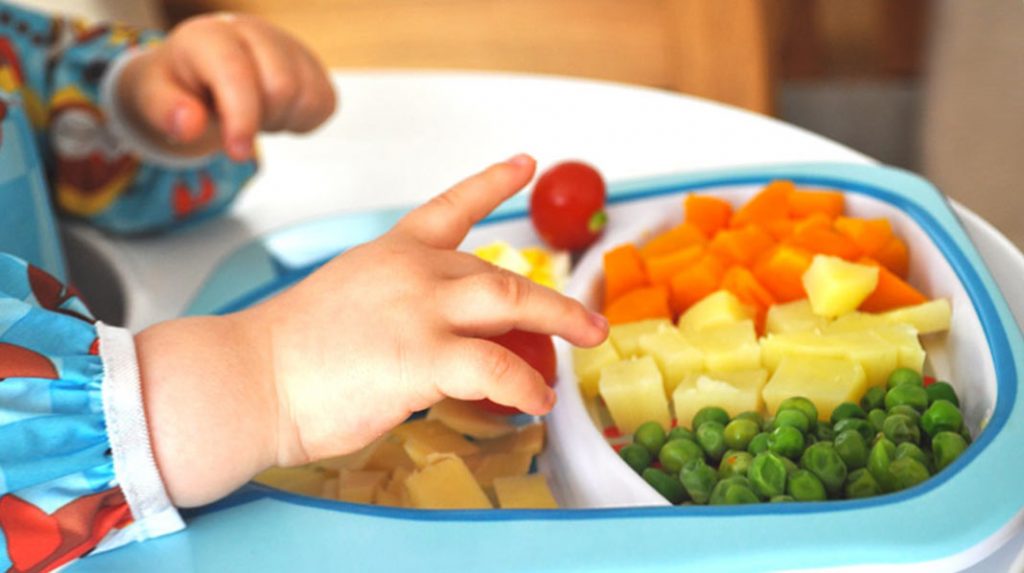
Your little bundle of joy has just flashed their first toothy smile. You find yourself going aww! Misty-eyed, you run to capture this angelic moment in your camera. I bet you can die 1000 deaths to experience this magical moment in your motherhood. Cherish the motherly love that is oozing out of every inch of your heart. Alright, now that your heart has had its fill, it’s time for your head to take over. The cooing and gurgling of your baby say they are now ready to explore the next level of flavors in their mouth.
This article is brought to you by qualified professionals and quality programs of Canada’s best early on centres selected by BabyBuddha. These centres respect the public health measures established by the Government of Canada, so the recommendations outlined below are safe to follow.
The First Gobbles
Now, the hand-eye coordination of your baby is improving. They would try putting anything and everything into their mouth. The mommy has to be extra vigilant. Give them the right options. If your baby can pick and eat any bite-sized, easy to eat pieces of food, you are offering them what is called finger foods.
Right Time to Introduce Finger Foods
After your child has become proficient with purees, you can start introducing them to finger foods. This is the case if you support the traditional approach to weaning. It will be different for every baby. Early years centre experts say when your baby turns eight or nine months, that is when you should introduce finger foods to them. Approximately at this point, your infant will have mastered the palmar grasp, will be working on developing the pincer grasp, and will have learned how to bring their hands to their mouth.
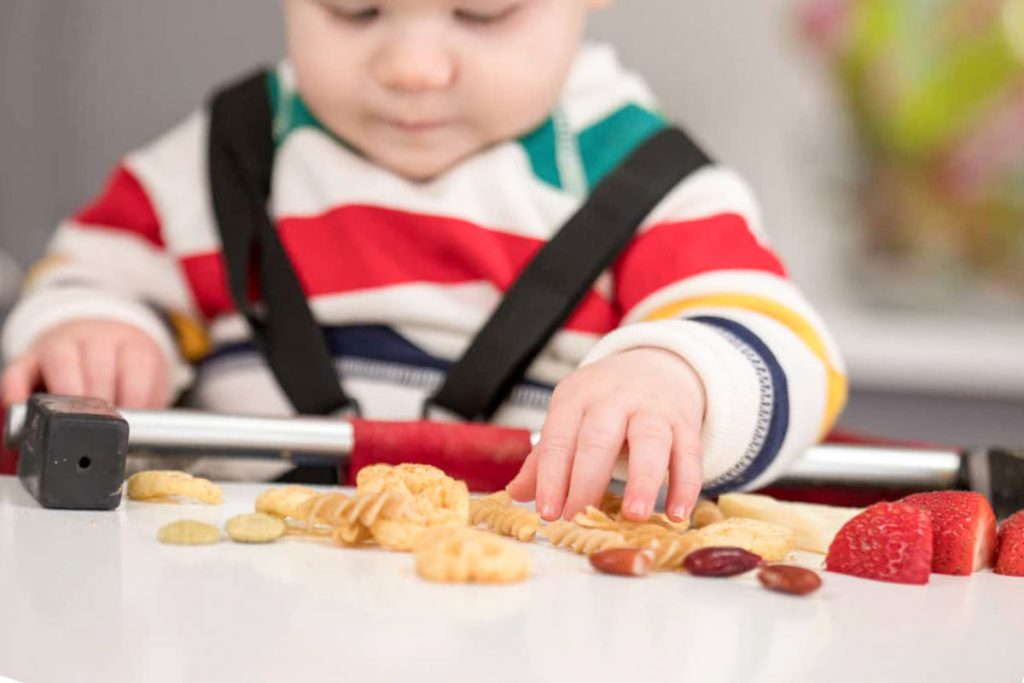
“The start of nutritionally-adequate and safe supplementary (solid) meals at 6 months,” is a recommendation made by the World Health Organization. Around the age of six months, those who adopt a baby-led weaning approach will often begin offering finger foods. After a period of being fed purees with a spoon, those who follow a traditional method to weaning will often begin introducing finger foods between the ages of 8 and 9 months.
Therefore, the precise age at which you should begin introducing finger foods to your infant can vary based on your baby and the strategy that you employ; nonetheless, the range of 6-8 months is considered typical.
Keep in mind, however, that your child may require starting later than the recommended age range based on circumstances such as early birth or any concerns regarding their development. It is generally suggested that you consult with your pediatrician regarding your strategy to introduce solid foods, especially finger foods.
Make sure your infant is displaying indicators of preparedness before introducing finger foods, including the following:
- Being able to sit with only minimal support
- Excellent command of both their head and their body
- They are putting their hands and toys in their mouths
- Appears to be interested in food, possibly demonstrating this interest by reaching for or leaning forward towards food.
Weaning the Baby
The practice of giving a baby finger foods from the very beginning, at an age of approximately 6 months or older, is referred to as baby-led weaning. Early on centres recommend not using purees at all if you follow this method of weaning your child.
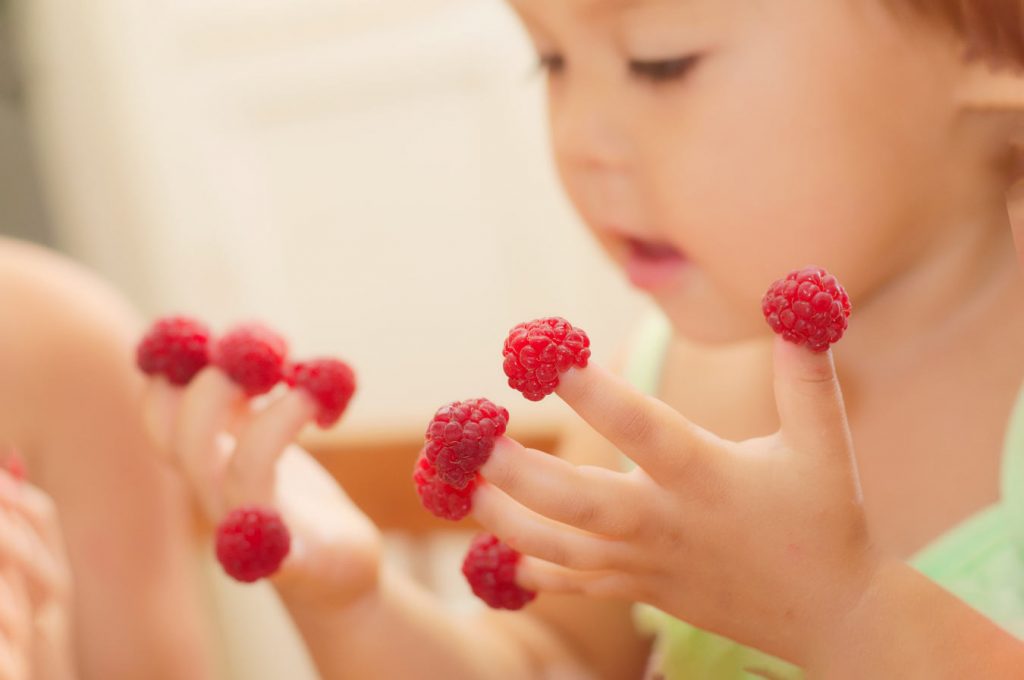
- Begin with soft items that can be eaten with your fingers. Think about fruits that are soft and ripe, like avocado, or vegetables that are soft and cooked, like sweet potato. To make it simpler to hold onto food, it should be sliced into pieces that are approximately the length and width of an adult’s pinky finger. Due to the fact that they do not yet have a pincer grasp at this age, cutting foods any smaller than this can be frustrating for a 6-month-old.
- Think about the texture. Cook meals to the point where they are tender enough to be lightly compressed between your thumb and index finger, but not to the point where they instantly transform into mush when handled. You should also make sure that the food is not too tough, as this could provide a choking risk.
- Help your baby get a better grasp. You can make it simpler for your baby to grip foods by giving them a light coating, such rolling a banana in finely crushed cheerios or crackers. This will make it easier for your baby to get a hold of the food. Adding texture to food with a crinkle cutter can provide a better hold.
How to Make Finger Food Meals
You will find a variety of methods for preparing fruits, vegetables, grains, proteins, and carbohydrates for your infant in the following paragraphs. Early on centres offer the following common guidelines to follow while you are preparing solid foods for your infant. Your baby has a few teeth, so look for soft textured, and easy to gum rather chew foods.

Foods that are meant to be eaten with fingers should be soft enough to be easily compressed between the two hands. You want the first foods you give your infant to be on the softer side so that they can bite, suck, chew, and move the food about in their mouths without any difficulty.
Method of cooking: some items, such as mangoes, bananas, avocados, and so on, are already soft enough for babies to eat without being cooked. Other fruits and vegetables that are particularly tough will have to be steamed or roasted.
The various serving sizes: for kids of 6-9 months, you will want to cut foods into strips measuring between 2 and 3 inches long. This is roughly the size of two adult fingers and makes it simple for newborns to use their palmar grasp on the food. When your baby is between 9 and 12 months old, you can start chopping foods into “pea size” pieces so that they can practice using their pincer grasp on the food.
Getting the Baby Ready
You’re ready to give your baby his or her first taste of solid finger foods, but you’re not quite sure where to begin. That’s why it’s not unreasonable to turn to parenting platforms like BabyBuddha to find helpful tips on feeding, dressing, parenting, etc.
Any wrong action can increase the risk of choking. The following are some actions that you may take to ensure that your first feeding goes off without a hitch.
- Seat your child comfortably in a baby chair. When you are feeding your infant, they should always be seated in a highchair or booster seat that provides adequate support for their trunk, hips, and feet. Make sure they have a footrest, and that their knees and hips are bent at an angle that is as close to 90 degrees as it can get.
- Be around to supervise. Always pay attention to your child’s indications and respond appropriately when feeding them. Allow the baby to choose whether or not they want to eat a certain portion of food, as well as how much of that portion they want to consume. As a parent, you may help your child develop healthy eating habits for later in life by letting them experience and express sensations of both hunger and fullness as they grow up.
- Start with pureed food. Some ideas for healthy first foods are fruits that are ripe and soft, such as bananas or avocados, or vegetables that have been cooked until they are very soft, such as sweet potatoes or carrots. For better handling, cut foods into stick-shaped pieces around the width of two adult fingers. This will ensure that the pieces are not too large. You might also give the baby a utensil that has been pre-loaded with one of the foods that has been pureed.
- Follow the thumb rule of limited food at a time to gauge their system’s reaction. Keep things straightforward and try out no more than three to five new foods at once. It is best to avoid placing an excessively large quantity on the tray or plate. Because we consume not only with our lips but also with our eyes, an excessive amount of food can sometimes be visually overwhelming for someone who is just starting out with eating.
- It is acceptable to place food straight on the tray of the highchair or the table. It is also acceptable for you to utilize the cute silicone divider plates and bowls. However, you should be aware that this is not required.
- Never force feed. Rather, sneak some food in. Take a small piece of the diced banana and feed it to your baby while they are busy smashing it. Having them smash bananas can keep them entertained, and they may even come to appreciate the taste of the fruit as well as the fun of smashing it. If they refuse to eat, there shouldn’t be any force-feeding. It’s critical that the high chair not turn into a parent-child battlefield.
Types of Finger Foods
The making of a fussy eater could be avoided by a pleasant first experience. Early Years Centre Ontario offers these options.
Raw Finger Foods

- Banana – small pieces
- Avocado – cubed form
- Tofu- diced
- Blueberries – halved soft ones
- Whole milk cheese – semi-hard / shredded
- Tomatoes – peeled, cubed
- Watermelon – cubed
- Puffed rice cereal
- Whole grain bread – hard crust removed
Cooked Finger Foods
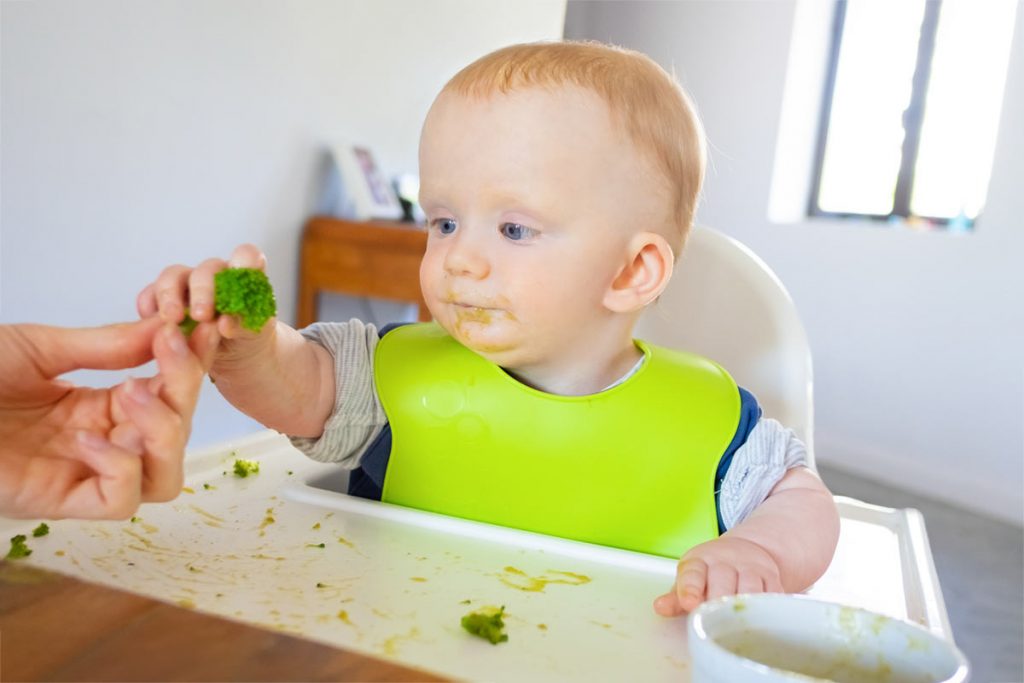
- Apple
- Peaches or pears
- Asparagus
- Carrots
- Zucchini – cubed, steamed
- Broccoli – chopped, steamed
- Sweet potato – cooked, diced/steamed/baked
- Whole green beans – cooked soft
- Chicken/meat – pureed/chunked
- Pasta – cooked spirals/macaroni
- Hard-boiled egg
- Cauliflower – chopped, steamed
- Fish – steamed/poached in broth, bones removed (white salmon, rainbow trout, tilapia)
- Potatoes – mashed
- Peas – cooked
Finger Foods to Avoid
There are certain foods that, based on how they are prepared, provide a high danger of choking to your infant. Because of this, it is recommended to delay giving your baby these foods until they are physically mature, which for certain foods may not be until they are between 2 and 4 years old.
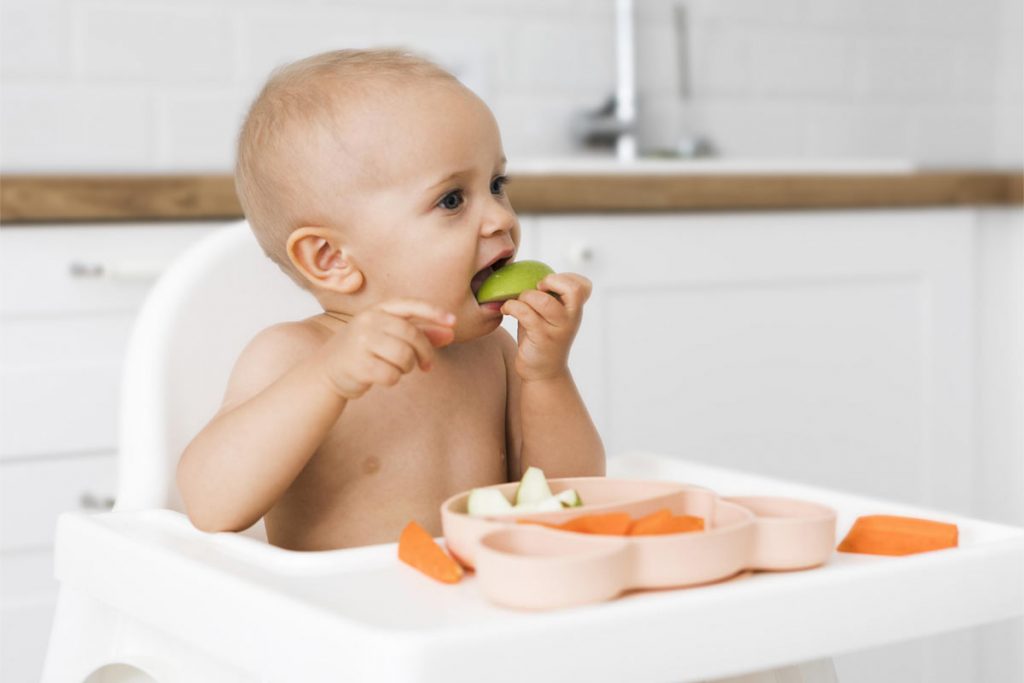
- Raw fruits and veggies (raw carrots, uncooked apple slices, celery, etc.)
- Unsliced cherry or grape tomatoes
- Unsliced grapes, cherries, and berries
- Balls of melon
- Dried fruit (raisins, dates, prunes, etc.)
- Nuts in their whole and chopped forms, as well as bits of nut butters
- Beef cut into large bits
- Hot dogs and several additional sticks of meat
- Fish that has bones in it
- Cheese cut into large portions
- Breads that are crusty or brittle
- Cookies, granola bars
- Popcorn
- Candies ranging from chewy to gelatinous
- Marshmallows
Other Things to Keep in Mind
There are a few more points that should be brought to your attention:

- Because of the risk of botulism, honey should not be consumed by infants under the age of one year.
- Avoid eating foods like eggs or meat that are served rare because they increase the chance of getting sick from a foodborne infection.
- If your child is less than one year old, you shouldn’t start giving them cow’s milk unless it’s in baked products.
- Due to the potential presence of listeria, unpasteurized dairy products and lunchmeats should not be provided.
- Because fat is essential for a baby’s proper growth and development, low-fat versions of foods, as opposed to their full-fat counterparts, should not be offered.
- The consumption of foods that are high in both salt and sugar can be detrimental to the health of infants.
Reducing the Risk of Accidents
Feeding your infant their first solid foods may be nerve-wracking. It can also become a delightful journey for both of you if you are prepared with the appropriate knowledge and safety measures. Early on centres, like Ontario Early Years Centre, have worked out helpful tips for a safer first feeding experience with finger foods.
- Always provide supervision when food is involved; sit with your baby while they eat, and try not to do other things at the same time.
- During any and all meals and snacks, the baby should be seated in an upright position rather than reclined. If you notice that your infant is becoming drowsy while eating, you should stop feeding them.
- As was mentioned earlier, meals that pose a significant choking risk should be avoided.
- Do not allow the infant to feed while moving. It is important to avoid letting your infant move around with food in their mouth or having food in their hands once they have learned to crawl or walk.
- Before you serve the food, make sure to check the temperature of the dish.
- Absolutely no eating in the car seat unless there is a responsible adult in the backseat with your child.
- After the baby is done eating, you should examine their mouth. During the process of learning to eat, some infants may develop a habit of storing food in the hollows of their cheeks or getting it trapped on the roof of their mouth. In the event that there is still any food in your baby’s mouth, you should urge them to keep chewing, spit it out if they feel the need to, or take a few sips of water or milk. It is important that you do not put your finger in your baby’s mouth to remove food since we want the infant to learn how to handle taking care of the food on his or her own. If you stick your finger in your baby’s mouth, it may cause the food to move deeper down your baby’s throat, making it more difficult to remove. This may also cause your baby to gag.
Putting not just your heart but also your mind into choosing finger foods is the essence of a happy motherhood. Happy building memories!
